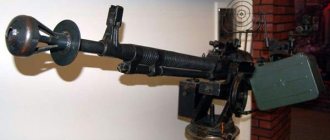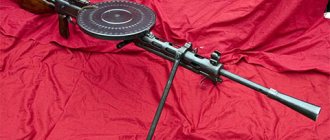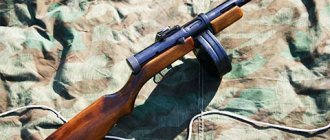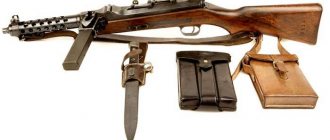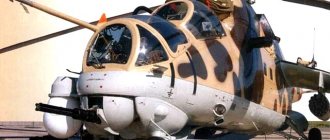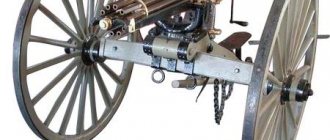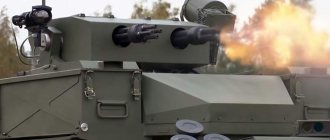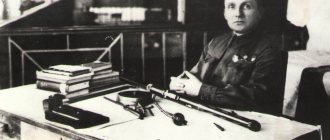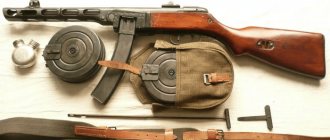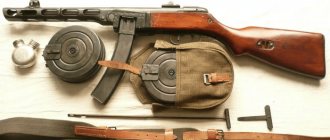After the end of the First World War and the Civil War, the small arms of the Red Army consisted of Mosin rifles and Maxim system machine guns; rare inclusions of Lewis and Shosh light machine guns did not make a difference. But at the same time, the modern concept of warfare required the presence at the squad and platoon level of mobile automatic weapons chambered for a rifle cartridge.
After the announcement of a competition for a light machine gun, which was supposed to replace foreign models, the eminent gunsmith, Vasily Alekseevich Degtyarev, got involved in the work. In 1923, work began on the creation of a modern light machine gun, which was to become the group weapon of the squad and platoon. Looking ahead a little, we will say that his work was crowned with success. DP - Degtyarev, infantry became the first light machine gun of the Red Army, on its basis tank and aviation modifications were subsequently developed.
History of creation
After an audit of the Red Army's weapons in the 1920s, commissions of auditors came to disappointing conclusions. The fleet of firearms was worn out, in addition, it consisted of dozens of different systems for various cartridges.
If everything was quite good in the field of personal weapons, foreign models were massively removed from service, replacing Winchesters and Arisakis with domestic rifle mod. 1895, the production of which was re-established in Tula. Nagan revolvers and Maxim machine guns were also produced in commercial quantities and there have been no problems with them yet.
But with light machine guns it was very bad. Fedorov assault rifles chambered for 6.5 mm Arisaka, British and American Lewis, French Hotchkiss and Shoshi. All this was thoroughly worn out. It required repairs, replacement and unnecessarily complicated logistics.
In 1923, a competition was announced to create a new light machine gun for the Red Army.
It was attended by eminent masters Fedorov and Tokarev, as well as V.A. Degtyarev. But in 1924, Tokarev’s design was adopted. At that time, the MT-25 machine gun based on Maxim was satisfied with the leadership of the Red Army, but Degtyarev’s machine gun was returned for modification. The MT-25 began to be prepared for release; moreover, small-scale production was established.
After a long and successful refinement, Degtyarev again presented his machine gun to the commission. This time, its characteristics completely satisfied the military and Degtyarev, and the infantry was accepted for the next tests.
After the January tests in 1927, the army immediately ordered a batch of machine guns for military testing, after which the machine gun was recommended to be put into production and at the same time adopted by the Red Army under the name DP. The number 27, indicating the year it was adopted into service, entered the history of the machine gun much later.
DP was produced at the Kovrov plant until 1944, before being replaced by DPM and later by RPD. After the war, outdated but still relevant machine guns were transferred to the troops of fraternal countries; the DP-27 fought in the jungles of Korea and Vietnam. It showed itself well in combat operations in the equator zone and desert-mountainous areas.
In 1944, a new weapon was developed, it was called the RPD - Degtyarev light machine gun, chambered for the 1943 model.
In the same year, a small batch was produced for military testing. The RP-44 or RPD machine gun had a belt ammunition supply from a metal box suspended from the machine gun body with a standard belt for 100 rounds.
The same tape went to the Goryunov machine gun, model 1943. The machine gun differed from earlier models in the presence of a pistol grip, a volume-shaped butt for ease of holding it when shooting, and the presence of a wooden fore-end with stops to hold the body of the machine gun when shooting in weight.
In the future, upon the adoption of the AK-47 assault rifle and the SKS carbine, it was the RPD that was the first handbrake to form a kit with them. Subsequently, the RPD was replaced by the Kalashnikov light machine gun. It just so happened that the requirements of unification forced the removal of an excellent machine gun from service.
Unlike the RPK, the RPD was not an enlarged copy of an assault rifle with a bipod, but a full-fledged machine gun chambered for an assault rifle cartridge. Significant ammunition, successful ergonomics and balance of the RPD made it unfamous. He fought in Vietnam, Africa and the Middle East.
Designation
The Degtyarev machine gun was adopted by the Red Army in 1927 with the official designation 7.62 mm light machine gun mod. 1927 g (7.62 mm light machine gun model 1927). It was called DP-27 (DP-27) or simply DP in use, in addition to the soldier's slang name "Player" mentioned above due to its disc-shaped magazine.
For unclear reasons, it is often called DP-28 in the West, although this designation was never used in any Soviet sources. Perhaps since the Soviets typically named equipment dating back to the first year of use, Western sources became confused between the 1927 initial service test date and the 1928 general service date and assumed it would be called the DP-28.
DP design
The machine gun was created according to the classical design, with ammunition supplied from a disk magazine located on top of the machine gun's receiver; the magazine capacity was 47 rounds. The operating principle of the automation is gas removal. Locking the barrel with lugs.
The stock has a neck, a slightly modified type compared to the rifle stock.
For convenience when shooting, the machine gun had a removable bipod. It is worth noting their unsuccessful design; during transportation, the bipod tended to become detached and lost. To minimize the flash of a shot, the machine gun had a conical flame arrester.
The barrel was half located in a perforated casing, which was also a continuation of the receiver. The return spring was located under the barrel, which again caused complaints, since heating the barrel during shooting also heated the spring, which negatively affected its durability.
Sights from the front sight at the end of the barrel casing in the muzzle and the rear sight with a notch up to 1500 meters.
Cartridges for RPD
The caliber of the Degtyarev machine gun is 7.62 mm chambered for 7.62x54 mm R cartridges.
Depending on the period of use, the following cartridges were supplied to the weapon:
- Light bullets of the 1908 model, designed for targeted destruction of infantry within 800 meters, destructive power remains up to 2500 m;
- Heavy bullets from 1930 with a range of up to 3500 m. They were used for shooting only in the absence of light ones;
- Cartridges with armor-piercing bullets of the 1930 model (B-30). Used against lightly armored vehicles (armored vehicles, tankettes) at a distance of up to 300 meters;
- Armor-piercing incendiary bullets of 1932 (B-32) were used against armored vehicles (tanks, gun emplacements, aircraft) with a focus on setting fire to fuel tanks;
- Tracer bullets (T-30 and T-46) - designed for target designation, shooting and fire adjustment.
The RPD magazine has some similarities with the Lewis machine gun, however, in practice their devices differ. For example, Lewis's magazine rotates due to the energy of the shutter and a complex system of levers. Degtyarev uses a pre-cocked spring for this in the magazine itself.
Operating principle when firing
The weapon is cocked by the bolt handle, which is located outside on the right under the magazine. The cocked gas piston is fixed at the end of the gas exhaust tube, the recoil spring is compressed, the bolt frame “sits” on the sear and holds the bolt with its thickening. The firing pin is hooked onto the vertical post at the end of the bolt frame. The safety holds the trigger.
When you grasp the neck of the butt, the safety key is pressed and the trigger is released.
When acting on the hook, it presses the sear down, which falls out of the groove of the bolt frame. The compressed spring in the channel presses on the piston and pulls the released bolt frame forward. The bolt frame begins to move, releasing the bolt, then the firing pin catches the bolt with its thickening and pushes it forward.
The bolt, having reached the magazine receiving window, lifts up the bar, which releases the cartridge. Next, the cartridge is caught by the bolt and sent into the chamber, the bolt rests against the barrel and stops moving. Only after this the trunk is considered closed. The bolt frame continues to move forward by inertia and pushes the firing pin further inside the bolt. The striker goes deeper and pushes the lugs apart, after which he hits the primer.
After the shot, powder gases follow the ejected bullet and enter the guide gas channel. The gas pressure is applied to the piston, which compresses the spring and at the same time pushes the bolt frame back. The bolt frame pulls the firing pin out of the lugs, and then, with its thickening, retracts the bolt.
The bolt moves away from the barrel, the cartridge case falls out, and the bar holding the new cartridge is released. The bolt frame “sits” on the sear (if the trigger is released). If the hook is pressed, then the bolt frame, having returned to its initial position and not encountering an obstacle, moves back under the action of a spring.
Tactical and technical characteristics of DP-27 and operating features
- Cartridge – 7.62x54 mm.
- Empty weight – 9.12 kg.
- Barrel weight – 2.0 kg.
- Empty (loaded) magazine weight – 1.6 kg (2.7 kg).
- The length of the machine gun with a flame arrester is 1272 mm.
- Barrel length – 605 mm.
- The initial bullet speed is 840 m/s.
- Magazine capacity - 47 rounds.
- Calculation – 2 people.
The DP-27 was used to support infantry with a machine gun squad as part of a platoon (according to the Red Army staff). The machine gunner's assistant carries a metal container with 3 magazines.
The machine gun itself had sufficient reliability and wear resistance, but despite this, a number of complaints were caused by almost “childhood” diseases of the machine gun:
- removable bipod;
- thin-walled trunk;
- small capacity and large magazine dimensions;
- inconvenient control of fire transfer;
- placement of the return spring under the barrel.
Almost all of these shortcomings were corrected in 1944, when the machine gun was modernized, during which it received a pistol grip and an integral bipod, and the spring was moved to the rear of the receiver. The machine gun is known as the DPM.
Degtyarev light machine gun
The light machine gun is the main support weapon for infantry units at the platoon-company level.
In addition to a high rate of fire, it has increased accuracy and range. It is used against enemy personnel and can also destroy light unarmored vehicles with appropriate ammunition. A light machine gun is indispensable both in defense and offensive operations. The main requirements for such weapons are reliability, reliability and efficiency. It was thanks to such indicators that the Degtyarev light machine gun became one of the most common weapons of Soviet units in World War II.
The technical characteristics of the DP (Degtyarev Infantry) turned out to be so good that the weapon was used as a captured weapon by both the Germans and the Finns. In the post-war period, it was actively supplied to the ATS countries, and is still in service with some states.
Interesting facts about DP-27
The first combat use took place in the Chinese Eastern Railway (the Soviet-Chinese conflict in 1929 in the Far East).
During the Soviet-Finnish War, captured weapons replaced the Finns' native machine guns.
The industry stopped the production of machine guns (Lahti-Saloranta) and put on an assembly line the production of spare parts for captured Soviet ones.
The machine gun was also mounted on motorcycles. Thus, it was possible to fire at low-flying targets, but for this it was necessary to stop the motorcycle, the shooter to come out of the cradle (stroller) and sit next to it for a steeper shooting angle.
DP-27 was produced by various friendly countries under license (Iran, China, etc.).
Participated in almost all hot spots on the globe. Operating weapons were found in the Civil War in Syria (started in 2011) and in the military conflict in eastern Ukraine (since 2014).
Types of machine gun
The Degtyarev machine gun was constantly improved in terms of improving technical and design characteristics, as well as for the use of weapons in various techniques. There are several modifications that are most widespread.
With the end of the war, most of them were withdrawn from service and sent to warehouses or as exports to the Allies. Taking into account such supplies, the DP also took part in post-war conflicts in Korea, Vietnam and other countries.
Small-caliber DP
A small-caliber modification of the DP was developed in the mid-1930s as a test model. The caliber of such a weapon is 5.6 mm chambered for a rimfire cartridge. Designer - M. Margolin.
This modification was used to train Soviet soldiers in shooting. It was not widely used, nor was it mass produced. For training purposes, a machine gun substitute for the Blum system was used instead.
DP with muffler
At the beginning of the Great Patriotic War, development of a silencer for DP was actively carried out. Several of these modifications were handed over to the troops in the Battle of Moscow. They did not become widespread, and already in 1942 similar designs were sent for revision.
Post-war tests were short-lived - the presence of a muffler did not ensure trouble-free sound suppression. Developments in this direction were stopped due to inexpediency.
DPM (Degtyarev infantry modernized)
The modernized Degtyarev DPM machine gun is a structural and technical improvement of the original from 1944. This is not really a modification, since we are not talking about an alternative weapon for specific purposes, but about a general increase in its effectiveness and reliability.
In this machine gun, the main attention is paid to the existing shortcomings of the DP. The recoil spring is placed in a special tube in the trigger frame under the butt. This significantly reduced its overheating during shooting.
The replacement of the barrel was simplified, and the bipod became an irremovable part of the weapon. The design of the butt and the handle were slightly changed. The weapon has become more stable and convenient. Combat characteristics and most technical characteristics remained unchanged.
YES (Degtyarev Aviation)
Degtyarev Aviation (DA) - a modification used on the R-5, U-2 and TB-3 aircraft. The casing was removed from the machine gun, protecting the machine gunner’s hands from burns. This provided better barrel cooling during prolonged shooting. For convenience, the butt was replaced with two handles. The magazine held up to 60 rounds.
The DA entered service back in 1928, and in 1930 its own modification, the DA-2, a twin unit, was developed. However, such machine guns were not widely used due to the small caliber of cartridges. Already in 1934, a specially developed ShKAS with a rate of fire of 1800 rounds per minute began to enter aviation service.
DT/DTM (Degtyarev tank)
Easel Degtyarev Tank (DT) - a modification designed jointly with G. S. Shpagin in 1929. Used in most tanks and armored vehicles. Taking into account the internal cramped conditions, the wooden stock was replaced with a retractable metal one. A special canvas sleeve catcher was also provided. For ease of use, Shpagin developed an installation that made it possible to aim the machine gun in the horizontal and vertical directions. If the vehicle failed, the weapon was removed and could be used by the crew for further combat operations. For this, removable bipods were used.
